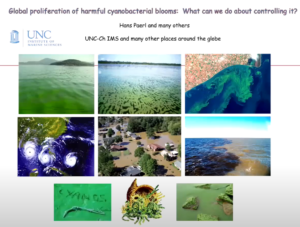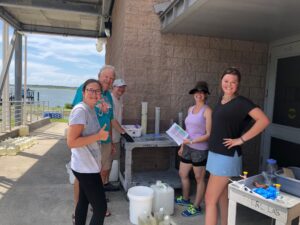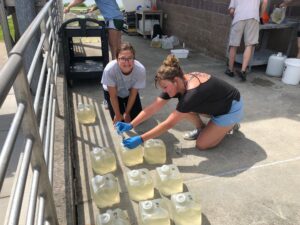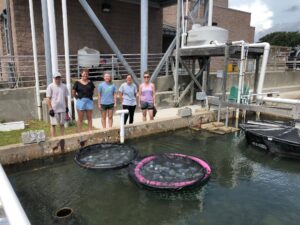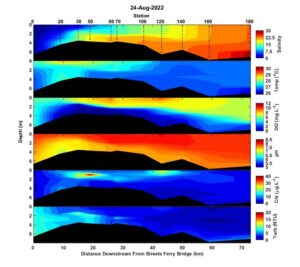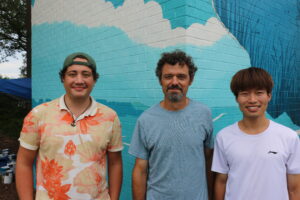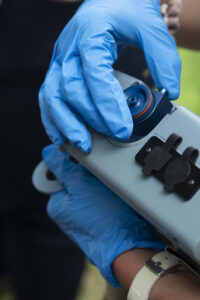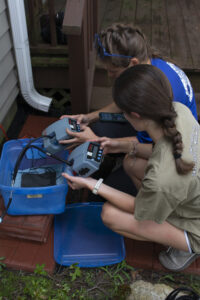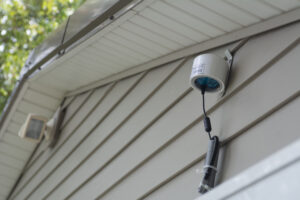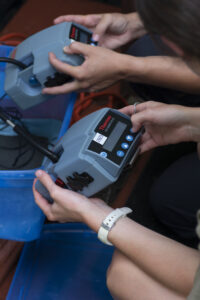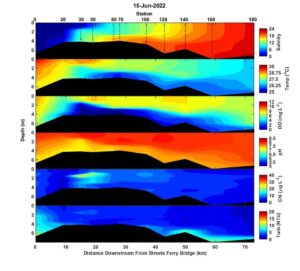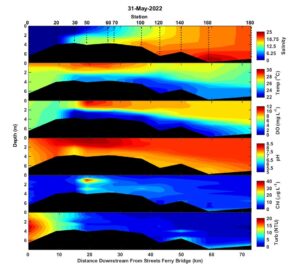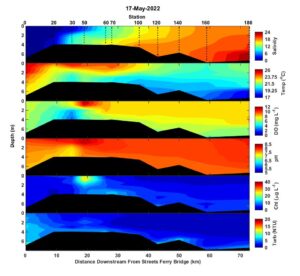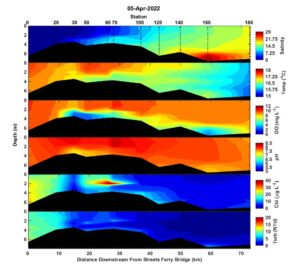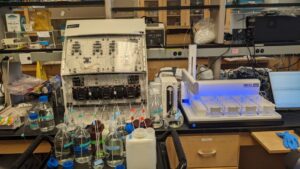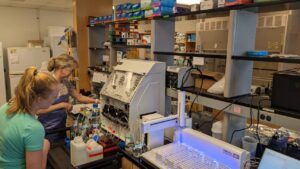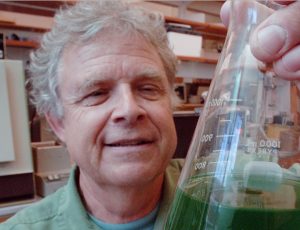Dr. Hans Paerl recently gave a talk for the Morehead City fieldsite’s ‘Seminar in Marine Issues’ course. He spoke on the global proliferation of harmful cyanobacterial blooms and what can be done to control them. A recording of his talk can be found here.
Author: leahmnel (Page 2 of 3)
Today the Paerl lab kicked off a third bioassay in collaboration with the Zhao Research Group at NC A&T, which is focused on determining the water quality impacts of landfill leachates (to learn more about this project click here). IE student Meg will be building off of this bioassay for her Independent Research Project and will be determining the effects that these leachates have on algal communities and their composition over an extended period of time. We are looking forward to seeing the results of her project!
Hi all,
Flows on the Neuse River have increased some and have fluctuated around the seasonal norm since the beginning of August. The estuary is still really salty though. Surface water salinity at station 180 was 24.2, a 99% value for the ModMon dataset. The recent modest freshwater inputs haven’t changed that situation much but they are helping to maintain strong stratification in the upper parts of the estuary. From station 20 to 70, surface to bottom salinity differences are about 10 and the bottom waters are anoxic. The crew reported a strong sulfide smell and the water in sample bottles was bright orange from oxidation of free dissolved iron. There was a broad zone of elevated chlorophyll from station 30 to station 120. Throughout most of this zone, the chlorophyll maximum occurred at 1 to 2 m depth. At station 120, the maximum was at the surface. I examined samples from station 50 and 120. Station 120 had a typical mixed bag of cryptophytes, small diatoms, and several medium to large dinoflagellates including Scrippsiella trochoidea, Levandarina fissa (aka Gyrodinium instriatum), and Pheopolykrikos hartmannii. Station 50 was dominated by tiny, ~4 um diameter centric diatoms, but also had a few Levandarina fissa, cryptophytes, and small chlorophytes. Turbidity at the head of the estuary was about 7 NTU. At station 30 and 50 there was a zone of elevated bottom water turbidity with a subsurface turbidity maximum > 10 NTU along the pycnocline. This happens occasionally when the bottom waters are truly anoxic. I think it results from chemical precipitation of reduced iron as oxic and anoxic waters mix.
I hope everyone enjoys a safe Labor Day weekend.
-Nathan
The Paerl Lab took a lab photo last week in front of IMS’s brand-new mural!
Pictured from left to right:
Back Row
Maxfield Palmer, Hans Paerl, Jeremy Braddy, Haley Plaas, Nathan Hall, Mingying Chuo
Front Row
Madison Sholes, Alex Sabo, Karen Rossignol, Leah Nelson, Randy Sloup
The Hall Lab, who we often collaborate on projects with, also got a lab photo.
Pictured from left to right: Maxfield Palmer, Nathan Hall, Mingying Chuo
This past week PhD student Haley Plaas and intern Madison Sholes deployed PurpleAir Sensors at pre-established sites along the Chowan River, where Cyanobacterial Harmful Algal Blooms (CHABs) are known to occur. In recent years, communities in northeastern North Carolina surrounding the Chowan River and Albemarle Sound have faced degraded water and air quality tied to a suite of environmental issues, including increased incidences of toxin-producing harmful algal blooms. Previous work done by Plaas et al. found that several aquatic cyanobacterial genera were detected in sampled particulate matter (PM), including two toxin-producing strains, Dolichospermum and Microcystis. These findings suggested a need for further research on the link between HABs and HAPs, i.e., the presence of Harmful Air Pollutants, in this region. The goal of this project is to investigate the association between indicators of CHABs and corresponding PM mass concentrations via the deployment of several PurpleAir sensors throughout the Chowan River and Albemarle Sound basin.
Haley and Madison deploying sensors in the field:
Photos taken by: Tom Brennan
Hi all,
As I’m sure you’re all aware, it’s still really dry. The Neuse River flow is less than half its seasonal norm. Salinity is still high along the estuary and salinity is >20 in the surface waters near the mouth. The tip of the salt wedge is still upstream of New Bern. The estuary is moderately stratified with surface to bottom salinity differences of ~8 at station 30 to ~ 2 at station 180. Warm bottom water temperatures (> 25 C) and stratification promoted hypoxia (< 2 mg/L) from stations 30 to 120 and even the lower stations had bottom water DO < 4 mg/L. A small subsurface maximum of chlorophyll a occurred along the pycnocline at ~ 1.5 m depth at stations 30 and 50. Microscopic examination of station 50 surface water revealed a phytoplankton community dominated by the summer bloom forming dinoflagellate, Levandarina fissa (formerly known as Gyrodinium instriatum). Its not known to produce toxins and hasn’t been associated with fish kills.
-Nathan
Hi all,
We finally got some rain in the basin on 26 May that sent river flows to nearly twice their seasonal norm. On May 31, the estuary was still really salty though. The salt wedge was upstream of New Bern and bottom water at New Bern (station 30) was ~ 10. Surface salinity at the mouth of the estuary was ~20. Water temperatures ranged from low 20s C in the bottom waters to nearly 30 C at the surface. The strong temperature gradient reinforced the vertical density gradient caused by salinity. Surface to bottom salinity differences ranged from about 10 upstream to 2 at the mouth. Hypoxic bottom water conditions were observed from the tip of the salt wedge at station 30 downstream to station 160. A subsurface zone of elevated chlorophyll (~40 ug/L) occurred at ~ 1 m depth at station 50. Microscopic observation of station 50 surface water indicated the phytoplankton community was dominated by small centric diatoms and cryptophytes. Generally, both small centric diatoms and cryptophytes are highly edible fuel for the estuarine food web. Elevated turbidity (15-20 NTU) at the freshwater head of the estuary is indicative of the elevated discharge conditions.
-Nathan
Hi all,
Conditions on 17 May 2022 were very similar to the previous sampling in April. The estuary is very salty with surface salinity almost 20 at the mouth. The tip of the salt wedge was upstream of New Bern which usually only happens during summer and fall drought. The estuary was normoxic with the exception of near the tip of the salt wedge at station 30 where dissolved oxygen was low < 4 mg/L but still sufficient for most estuarine fish. A small zone of elevated chlorophyll a (~25 ug/L) was observed at station 50. Microscopic analyses showed dominance by small centric diatoms and a few cryptophytes.
-Nathan
River flow has been below normal for most of the spring but there were some high flows in late March. On April 5, the upper estuary was freshened by those high flows with surface salinity < 5 downstream to station 70. Surface salinity at the mouth was ~18 which is unusually salty for spring. Despite cool water temperatures (< 20 C), low bottom water dissolved oxygen (< 4 mg/L) was observed in the upper estuary at stations 30 and 50 and within the high salinity intrusion of bottom water from the intercoastal waterway at station 160.
A subsurface zone of high chlorophyll a was observed along the pycnocline at ~ 2 m depth at stations 60 and 70. Microscopic analysis of surface water from station 60 showed a mixed bag of spring dinoflagellates, Prorocentrum minimum, Heterocapsa rotundata, Heterocapsa triquetra, small centric diatoms, and cryptophytes. These dominant species are not known to produce toxins. Karlodinium veneficum, a toxic fish killing dinoflagellate, was present in low numbers. Turbidity was highest (8-10 NTU) at the head of the estuary. Throughout the rest of the estuary turbidity mainly ranged from 2-3 NTU except at stations 60 and 70 within the zone of high phytoplankton biomass where turbidity was ~5 NTU.
-Nathan
The Paerl Lab installed and received training on a new SEAL Analytical QuAAtro39 Continuous Segmented Flow Analyzer last week. The QuAAtro is a wet-chemistry analyzer that is used to automate complex chemical reactions. QuAAtro uses the principle of air-segmented continuous-flow analysis where samples are mixed with reagents in a continuously flowing stream. This instrument has four manifolds that can be run at once, allowing for the concentration of Nitrate, Ammonium, Phosphate, and Silicate in a sample to be determined simultaneously. This new method of nutrient analysis will provide ultra-low detection limits and exceptional reproducibility, while also allowing for faster analysis. We are excited to put our new QuAAtro to use!
Pictures taken during training:
